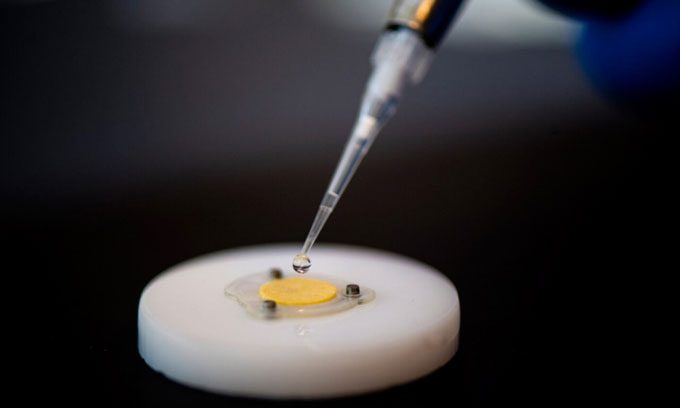A tiny fingertip-sized sensor that can be attached to clothing changes color to signal safe sun exposure time.
Prolonged sun exposure can cause various harms, and in recent years, scientists have proposed several intriguing technological solutions to alert users when it’s time to seek shade. A team of experts at Northeastern University (USA) has added a new solution stemming from a serendipitous discovery related to how squid change color, as reported by New Atlas on February 25. The research was published in the journal ACS Sensors.

The UV sensor consists of five layers of plastic and a light-sensitive paper. (Photo: Alyssa Stone/Northeastern University)
Initially, the team at Northeastern University studied how marine creatures with tentacles, such as squid, can easily blend into their surroundings. In their research, they identified a range of pigments, chemical reactions, and mechanisms that facilitate this camouflage method, including one noteworthy factor.
Named xanthommatin, this small molecule gives squid their vivid colors. The scientists demonstrated that xanthommatin can be manipulated to achieve color-changing capabilities. They continued to explore how to apply it to clothing or other consumer products.
When placing xanthommatin on a laboratory table under light to test its stability in everyday conditions, the scientists were disappointed to find that it could not maintain its color. “Seeing it change color under light was quite disheartening,” said Leila Deravi, an associate professor of chemistry and biochemistry at Northeastern University.
However, some members of Deravi’s team had previously researched microfluidics from paper and wondered about leveraging the newly discovered light-sensitive properties of this molecule as a foundation for a new type of ultraviolet (UV) sensor. Thus, they created a fingertip-sized device that can be attached to shirts or swimsuits. The device consists of five layers of thin plastic along with a treated round paper that is then dried.
The device also integrates a “button” that releases a solution from a small reservoir at the edge. The solution flows through the channels in the plastic layer and moistens the paper. This activation causes the wet paper to react to UV radiation, changing from yellow/orange to red with increased UV exposure.
The team tested the device and found it worked well in various circumstances. They adjusted it according to the UV levels people might encounter in different situations, even applying sunscreen to make it change color much more slowly.
“I think you will always be surprised by the safe sun exposure time. It really depends on the weather and can be just a few minutes,” said study author Dan Wilson.
The scientists believe that in addition to monitoring sun exposure levels, the new device could also be used in situations requiring UV radiation measurement, such as when disinfecting surfaces.



















































